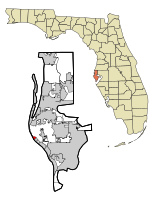|
Redington Shores, Florida
Redington Shores is a town in Pinellas County, Florida, United States. The county is part of the Tampa–St. Petersburg–Clearwater Metropolitan Statistical Area, more commonly known as the Tampa Bay Area. The population was 2,176 at the 2020 census. GeographyThe approximate coordinates for the Town of Redington Shores is located at 27°49′41″N 82°49′50″W / 27.82806°N 82.83056°W (27.827965, –82.830509).[5] According to the United States Census Bureau, the town has a total area of 1.2 square miles (3.1 km2), of which 0.4 square miles (1.0 km2) is land and 0.8 square miles (2.1 km2) (67.50%) is water. According to Elevation Map Logs, the elevation of Redington Shores is just one meter above sea level. ClimateThe climate in this area is characterized by hot, humid summers and generally mild winters. According to the Köppen climate classification, the Town of Redington Shores has a humid subtropical climate zone (Cfa).[6] According to Weather Underground, the historical average day temperature is 79.7 degrees Fahrenheit (°F), with the high averaging around 88.3°F and the low being 71.9°F degrees. Redington Shores faces high wind speeds averaging around 9 miles per hour. The close proximity to the ocean brings a recurring ocean breeze that cools the beach area. Demographics
2010 and 2020 census
As of the 2020 United States census, there were 2,176 people, 1,138 households, and 564 families residing in the town.[10] As of the 2010 United States census, there were 2,121 people, 1,037 households, and 518 families residing in the town.[11] 2000 censusAs of the census[3] of 2000, there were 2,338 people, 1,292 households, and 658 families residing in the town. The population density was 5,955.4 inhabitants per square mile (2,299.4/km2). There were 2,101 housing units at an average density of 5,351.7 per square mile (2,066.3/km2). The racial makeup of the town was 97.60% White, 0.21% African American, 0.47% Native American, 0.47% Asian, 0.30% from other races, and 0.94% from two or more races. Hispanic or Latino of any race were 2.95% of the population. In 2000, there were 1,292 households, out of which 8.9% had children under the age of 18 living with them, 43.5% were married couples living together, 5.2% had a female householder with no husband present, and 49.0% were non-families. 41.3% of all households were made up of individuals, and 20.0% had someone living alone who was 65 years of age or older. The average household size was 1.81 and the average family size was 2.38. In 2000, in the town, the population was spread out, with 9.2% under the age of 18, 3.1% from 18 to 24, 19.7% from 25 to 44, 34.0% from 45 to 64, and 34.0% who were 65 years of age or older. The median age was 55 years. For every 100 females, there were 95.2 males. For every 100 females age 18 and over, there were 94.6 males. In 2000, the median income for a household in the town was $40,411, and the median income for a family was $49,300. Males had a median income of $36,719 versus $30,662 for females. The per capita income for the town was $31,822. About 5.5% of families and 8.2% of the population were below the poverty line, including 14.6% of those under age 18 and 8.3% of those age 65 or over. EcologyRedington Shores is home to numerous plants and organisms which thrive around the beach and ocean.[12] Plants on the beach include mangroves, sea oats, and sea grapes. All of these organisms prevent erosion on the dunes and are essential to organisms around them. The mangroves are protected due to the State's “Mangrove Trimming and Preservation Act.” A population of coyotes and loggerhead turtles can be found in Redington Shores. Karenia brevis, red tide, causes problems in the ocean at Redington Shores. An increase of this organism in the ocean causes harm to organisms around it. Due to the high concentration of K. brevis in the Gulf of Mexico, Redington Shores faces problems with deadly impacts on marine life. LibraryThe community is served by the Gulf Beaches Public Library, located in nearby Madeira Beach. The library is supported by Madeira Beach, Redington Beach, North Redington Beach, Redington Shores, and Treasure Island. These five communities have combined their resources in order to fund the library.[13] References
External links |
||||||||||||||||||||||||||||||||||||||||||||||||||||||||||||||||||||||||||||||||||||||||||||||||||||||||||||||||||||||||||||||||||||||||||||||||||||||||
Portal di Ensiklopedia Dunia



